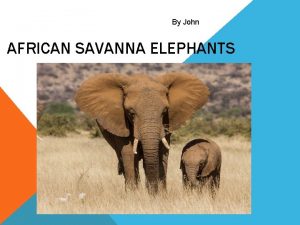Animal Adaptations Are All Elephants the Same African










- Slides: 10

Animal Adaptations: Are All Elephants the Same?

African Elephant The African Elephant is the largest living land animal. These mammals have very strong social bonds and live in family groups headed by a female (called a cow). Males (called bulls) occasionally join the group.

African Elephant Anatomy: African elephants average about 10 feet tall at the shoulder, weighing roughly 6 tons. Males are larger than females. Both males and females have tusks (large, pointed ivory teeth). They have wrinkled, graybrown skin that is almost hairless.

African Elephant Ears: African Elephants have large ears (up to 5 feet long) that are shaped like the continent of Africa. The ears not only hear well, but also help the elephant lose excess heat, as hot blood flows near the surface of the skin.

African Elephant Trunk: Elephants breathe through two nostrils at the end of their trunk, which is an extension of the nose. The trunk is also used to get water and food. To get water, the elephant sucks water into the trunk, then curls the trunk towards the mouth and squirts the water into it. The trunk has two prehensile (grasping) extensions at the tip, which it uses like a hand.

African Elephant Diet: Elephants eat roots, grasses, leaves, fruit, and bark. They use their tusks and trunk to get food. These herbivores spend most of their time eating. Bulls can eat up to 300 -600 pounds (130 -260 kg) of food each day.

Asian Elephant The Asian Elephant (also known as the Indian Elephant) is a huge land animal that lives in India, Malaysia, Sumatra, and Sri Lanka. It is related to the Woolly Mammoth. This elephant is used extensively for labor; very few are left in the wild. Their life span is up to 70 years. This mammal has very strong social bonds and lives in family groups headed by a female (called a cow). Males (called bulls) occasionally join the group. Elephants are excellent swimmers. Elephants have few natural enemies except man, and they are in extreme danger of extinction due to loss of habitat and poaching (they are killed for their ivory tusks).

Asian Elephant Anatomy: Asian Elephants average about 8 feet tall at the shoulder. Males weigh up to 6 tons; females average about 4 tons. Only males have tusks (large, pointed ivory teeth). They have wrinkled, gray-brown skin that is almost hairless. The ears not only hear well, but also help the elephant lose excess heat, as hot blood flows near the surface.

Asian Elephant Trunk: Elephants breathe through two nostrils at the end of their trunk, which is an extension of the nose. The trunk is also used to get water and food. To get water, the elephant sucks water into the trunk, then curls the trunk towards the mouth and squirts the water into it. The trunk has a prehensile (grasping) extension at the tip, which it uses like a finger or scoop.

Asian Elephant Diet: Elephants eat roots, grasses, leaves, bark, bananas and sugar cane. Working bulls can eat up to 300 -600 pounds (130 -260 kg) of food each day.



















